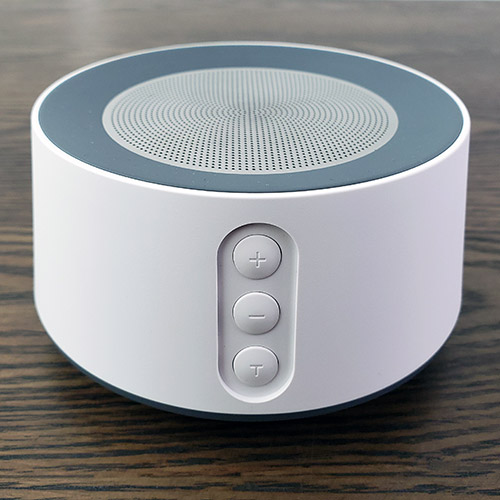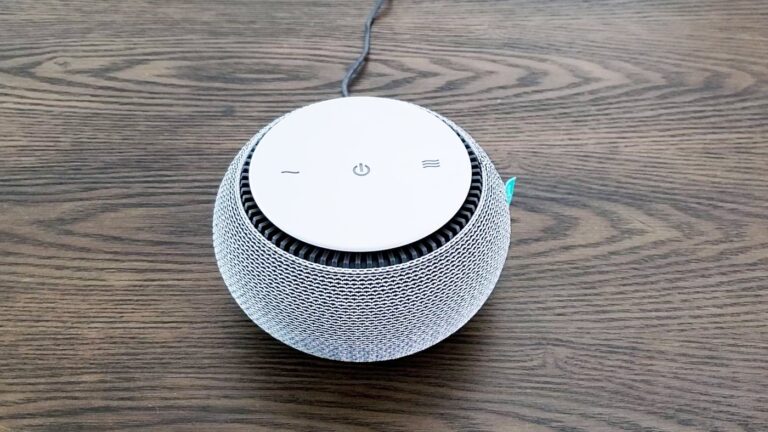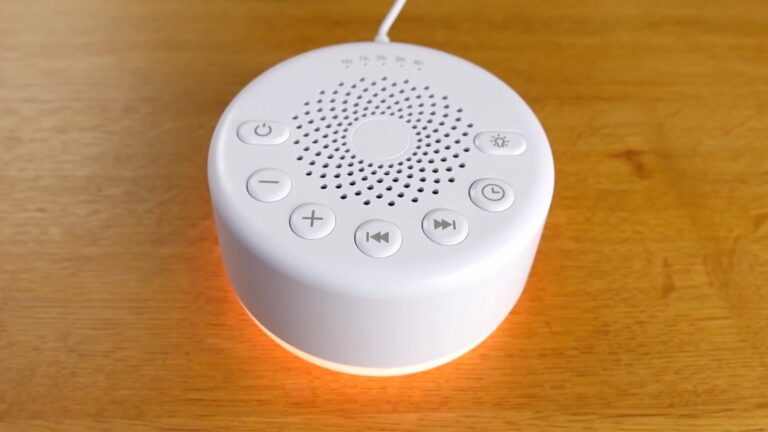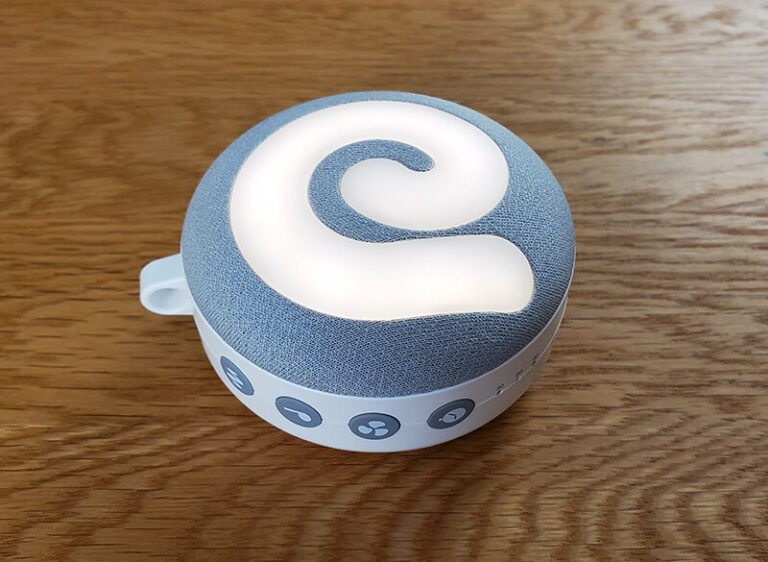Disclosure: My website is reader supported. If you purchase a product after clicking a link, I may receive a commission, at no extra cost to you. Learn more.
Overview
In the video above, I answer the most common questions people ask me about white noise machines. I also talk about alternative ways to play white noise, such as through Bluetooth speakers and phone apps. And I then share some tips for choosing a white noise machine.
If you prefer, you can read the transcript below. And if you’re interested in getting any of the devices I discuss, you can skip to the links section.
Video transcript
Hi, I’m Ethan Green from No Sleepless Nights. In this video, I’m going to be talking about white noise machines, and also phone apps, household appliances like the fan by my shoulder there, and smart speakers.
Specifically, I’m going to be trying to answer some of the most common questions that people ask me in the comments section of video reviews of white noise machines I’ve done in the past, and on my blog.
For example, why should they buy a white noise machine that has recordings of fan sounds when they could just listen to a real fan that they already have?
Or why would they listen to looped recordings of nature sounds when they could just download an app on their phone and do exactly the same thing, or use a smart speaker. These are very valid questions and there are more as well that I’m going to try and answer.
My aim is to try and help you decide whether, A) you even need a white noise machine in the first place – if I can help you save some money then that’ll make me happy. And, B) if you do decide that you want one, which one? Because there are so many to choose from nowadays.
Part 1: comparing white noise machines with a normal fan, phone apps, and smart speakers
Is a real fan better than a white noise machine?
This section starts at 1:01 in the video
So, let’s get started with what I would say is one of the most classic questions of all. As I’ve mentioned: why would you buy a white noise machine and listen to fan recordings when you could just turn a fan on that you already have? So before I give you my thoughts on that one, let’s have a listen to a normal fan.
Okay, now let’s have a listen to the Snooz, which has a mechanical fan inside it.
In this photo, you can see the Snooz white noise machine. It has a real fan inside instead of recordings.
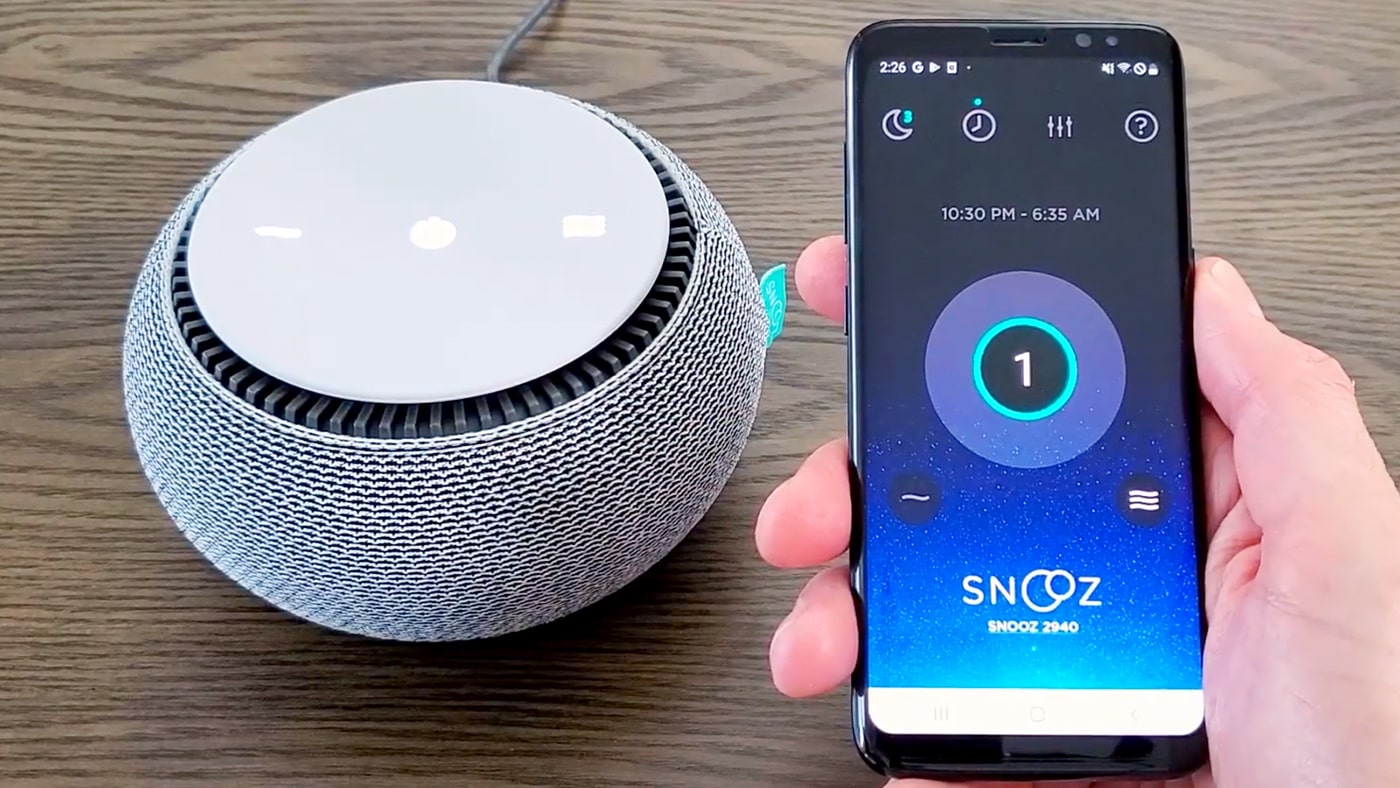
And now let’s listen to the Lectrofan evo. Okay, so when I listen to those, it’s really clear to me that they all sound quite different. And this is just a small selection.
Here you can see the Lectrofan evo:
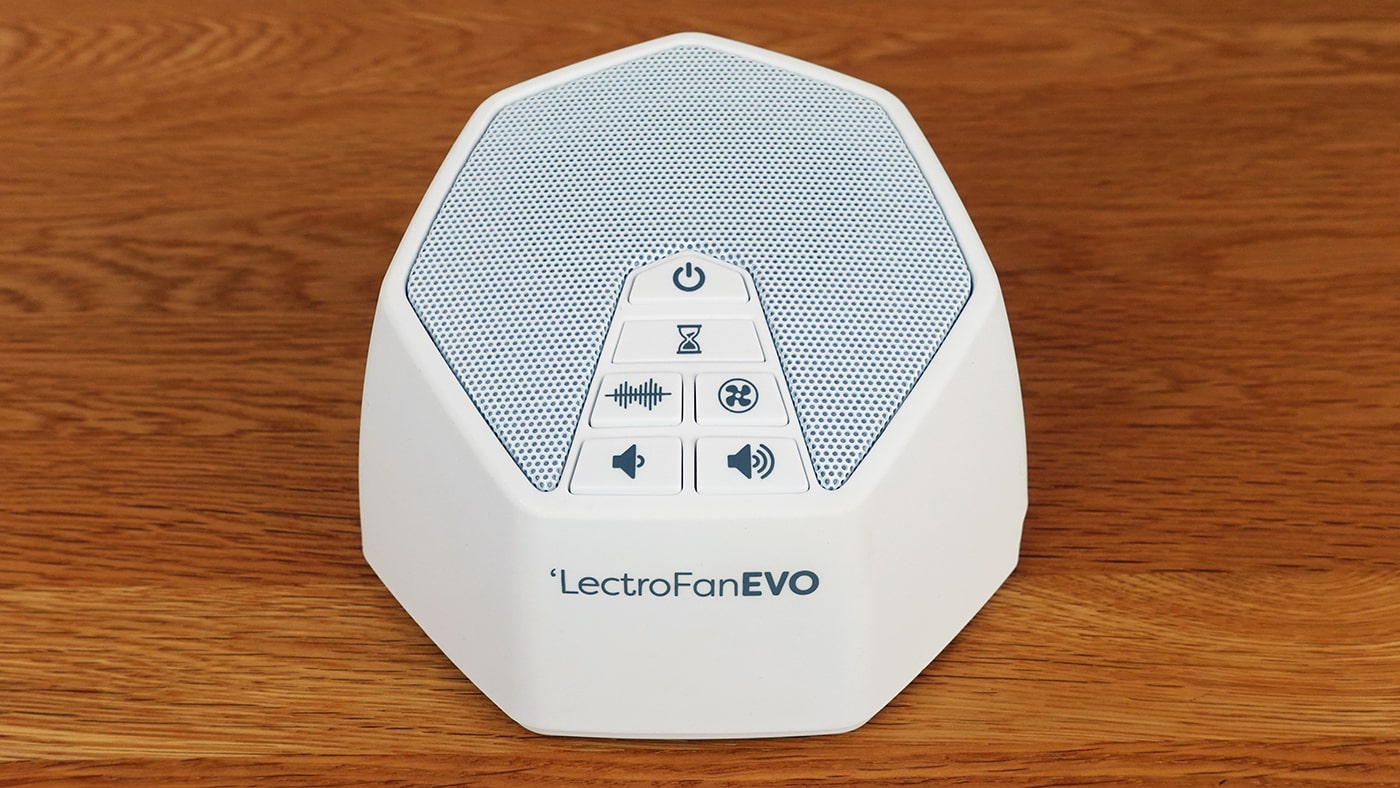
At the end of the day, every white noise machine with fan recordings and every real fan is going to sound a little bit different. So it’s a case of finding just the right one for you or having one that you can experiment with. And that’s something that I think is worth pointing out; if you’ve already got a fan and you like the sound of it then stick with that – you don’t need to buy a white noise machine.
But if you’re thinking of buying a fan then I really recommend trying to find a store where they’ll allow you to test out the fan sounds and turn a couple on and off. That way, you can make sure that you like the sound that it produces and that it doesn’t have issues like a rattly component, which is going to ruin the effect, or you can hear the sound of the motor rather than the sound of the fan. I think it’s useful if you can check out the sound beforehand.
Now, if you want a little bit more control over the sound of the fan, because at the end of the day, with a real fan you might have a couple of speed settings and you might be able to change where you place it in the room, but that’s not going to do much about the tone. This one here, for example, the Snooz – I personally really like the sound that it makes. It just has a really nice, rich rushing air sound, and you can change the tone by adjusting the cap.
So you’ve got more of a chance of playing around with it to find just the right settings, especially for your bedroom, which I think is a good thing. It also has a couple of other useful features like auto-off timers and an app, so you can use it when you’re in bed if you’ve got it on the other side of the room.
Now, if you’re not too worried about having the authentic sound of a real fan and you’d actually like variety, then a white noise machine like the Lectrofan Evo or the Avantek give you a bit more variety.
And that’s a good thing if you’ve got different noises on different nights that are disturbing your sleep. You can play around with the settings, and perhaps one night a soft fan like this one might do the trick. And perhaps on another night, you’ll need a kitchen extractor fan sound like the one behind me there. And that might be what you need to block out noise and be able to relax and sleep.
So really, that’s the main draw of listening to a fan sound on a white noise machine – just the variety that it offers. At the end of the day, I don’t think there’s a right or a wrong answer when it comes to sticking with a real fan or a white noise machine. It’s just a personal choice, so I’ll leave that one to you to decide.
Which device to use in the bedroom
This section starts at 4:02 in the video
Another very important point to consider is where you’re actually going to be listening to white noise. I think if you’re going to be listening to it during the daytime, there’s no real standout device or piece of tech that I think is better than all the others. I think whatever works for you is the one to use.
Whether it’s your smart speaker, your phone, an app, a laptop, computer, television, or white noise machine – they’re all equally good as long as they actually do what you want them to do, which is probably block out external noise and have a sound that’s relaxing. Whatever works, works.
In the nighttime, I think there are some reasons why a white noise machine might be a better option than some of the other devices though.
Firstly, if you’ve got a fan, use that. No problem, I’m not going to dispute that.
But if you’re going to use your phone and an app, I personally wouldn’t do that in the nighttime. Mainly because I just don’t like to have my phone on my nightstand because it means I’m more likely to pick it up and play with it when I should be trying to go to sleep: something that I know many people struggle with.
Another issue is that if you want to change the settings in the night time then at least with a white noise machine you can lean over and quite easily, just with the flick of a button, turn it on or off or change some settings.
However, with a phone app, you need to get your phone, turn it on, unlock it, have the light come into your face which can be a little bit disruptive, and then play around with the settings in the app. It’s one step too far for me in the nighttime. I just want to be able to lean over and turn it off or adjust the volume.
Another good thing with the white noise machines where the light is concerned is that even if they do have a night light you can turn it off. And if they’ve got LEDs, they tend to be really tiny so they’re not going to be disruptive to your sleep. And many of them don’t have any lights whatsoever; they just kind of sit there simply in the darkness, which is a good thing.
Another thing that you can do with the white noise machines that you might not want to do with your phone is place them further away than your nightstand.
That can be a good thing I think, mainly because if you’ve got noise coming from another room in the house you can put it by the door. Or if noise is coming from outdoors, you can put it on a windowsill, and that’s going to potentially be more useful than having it right next to your head.
It’s something that you can experiment with, whereas if you’ve got your phone you probably want it on your nightstand like most people do I suspect.
I also don’t like having smart speakers in the bedroom, not because I’m worried that they’re listing out for me – at least don’t think they are – but more because I just like to have one on in the house and that’s generally in the living room. I don’t like to unplug it and move it around the house.
Now, when it comes to placement there’s another reason to consider a white noise machine, which is in a child’s bedroom.
Here you can see the warm glow of the Dreamegg D11 nightlight:
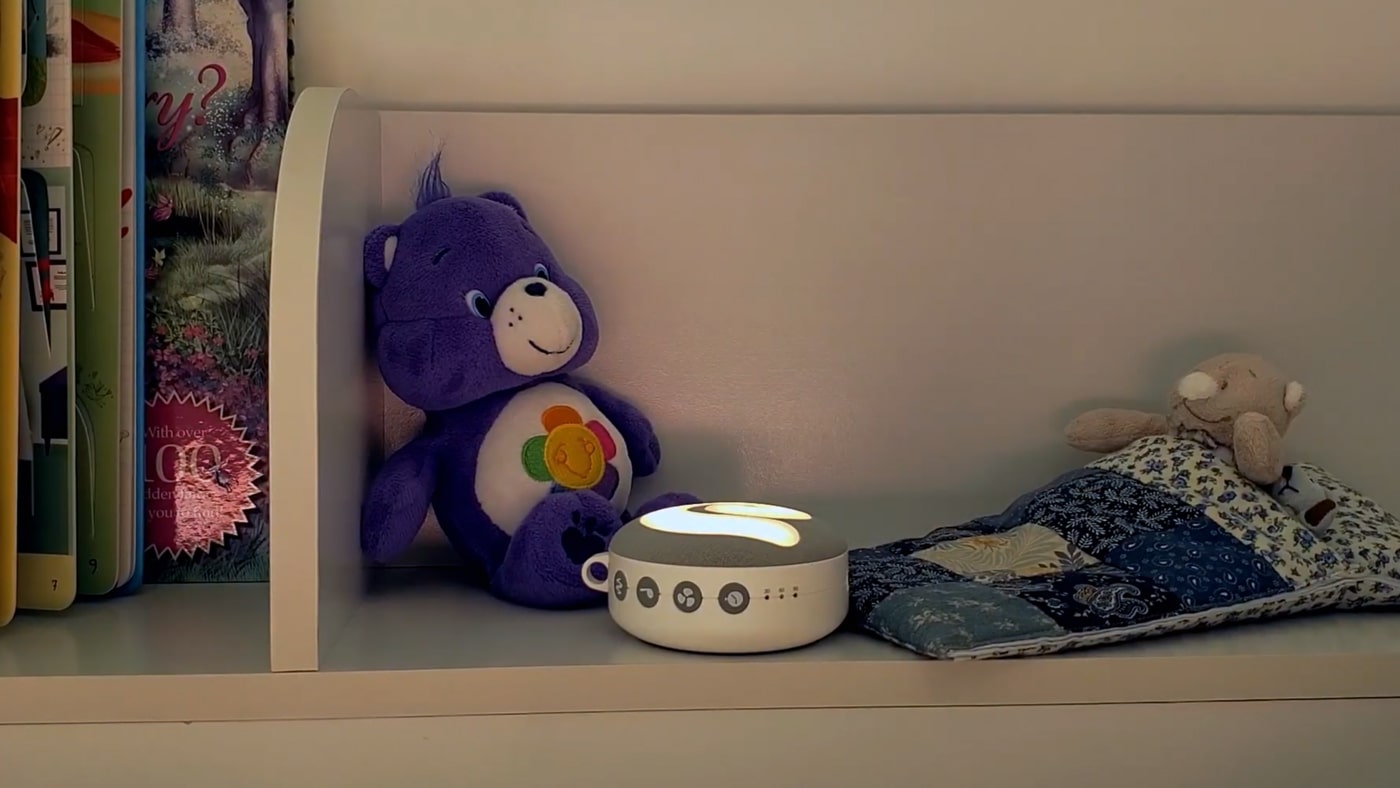
The main reason is that you probably don’t want to leave your smartphone in a kid’s bedroom. I certainly wouldn’t and I imagine many people don’t either. With a white noise machine, you can just pop it in there, put the settings on that you want, ideally with a timer and a low volume, and keep it far away from the head if you can. You don’t want it right next to their bed in a kid’s bedroom.
A white noise machine just gives you all those options in a nice simple way. So for a kid’s bedroom, I would definitely recommend a white noise machine instead of a phone app or a smart speaker.
3 white noise apps I recommend
This section starts at 6:42 in the video
Okay, if you do decide that you’d like a phone app, there are loads to choose from and pretty much all of them are free to download. So you can try them out and if you don’t like them just delete them and try another one. These are three I recommend trying.
First, we’ve got the White Noise Generator, which is really simple to use.
In this photo, I’m using the White Noise Generator app:
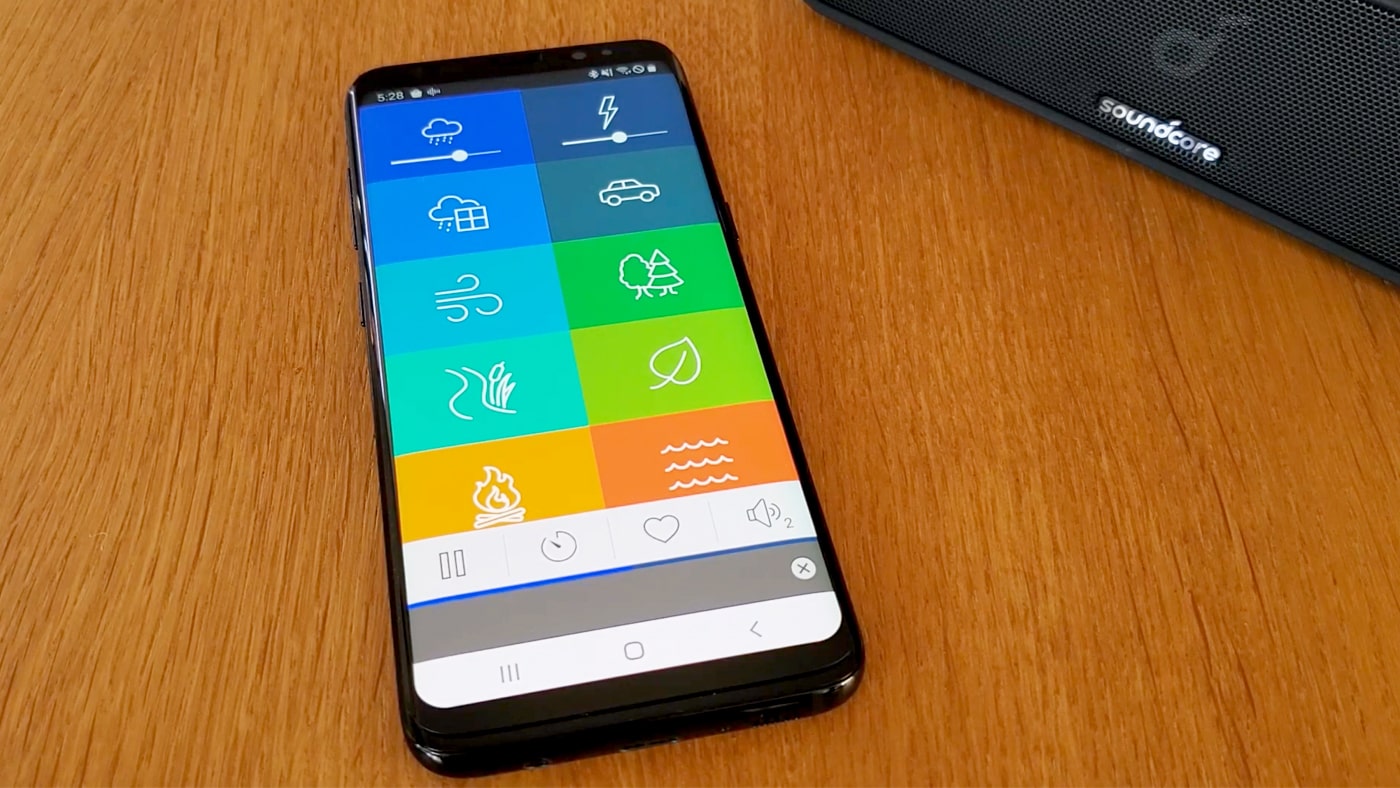
You can just choose any of these options and combine them, so let’s have rain and thunder.
As you can see, there’s a banner Ad down the bottom, which is a very common kind of Ad. You can either tolerate it if you want it for free, or you can pay to get rid of it. I think this one, let me see – you need to pay $24.99 for a year or $2.99 for a month. I’m not going to do either of those things though!
Next, the Noise Generator is another one that I like. This is a good one if you want white noise and different colors. So let’s try the brown noise.
Below, you can see the noise Generator app:
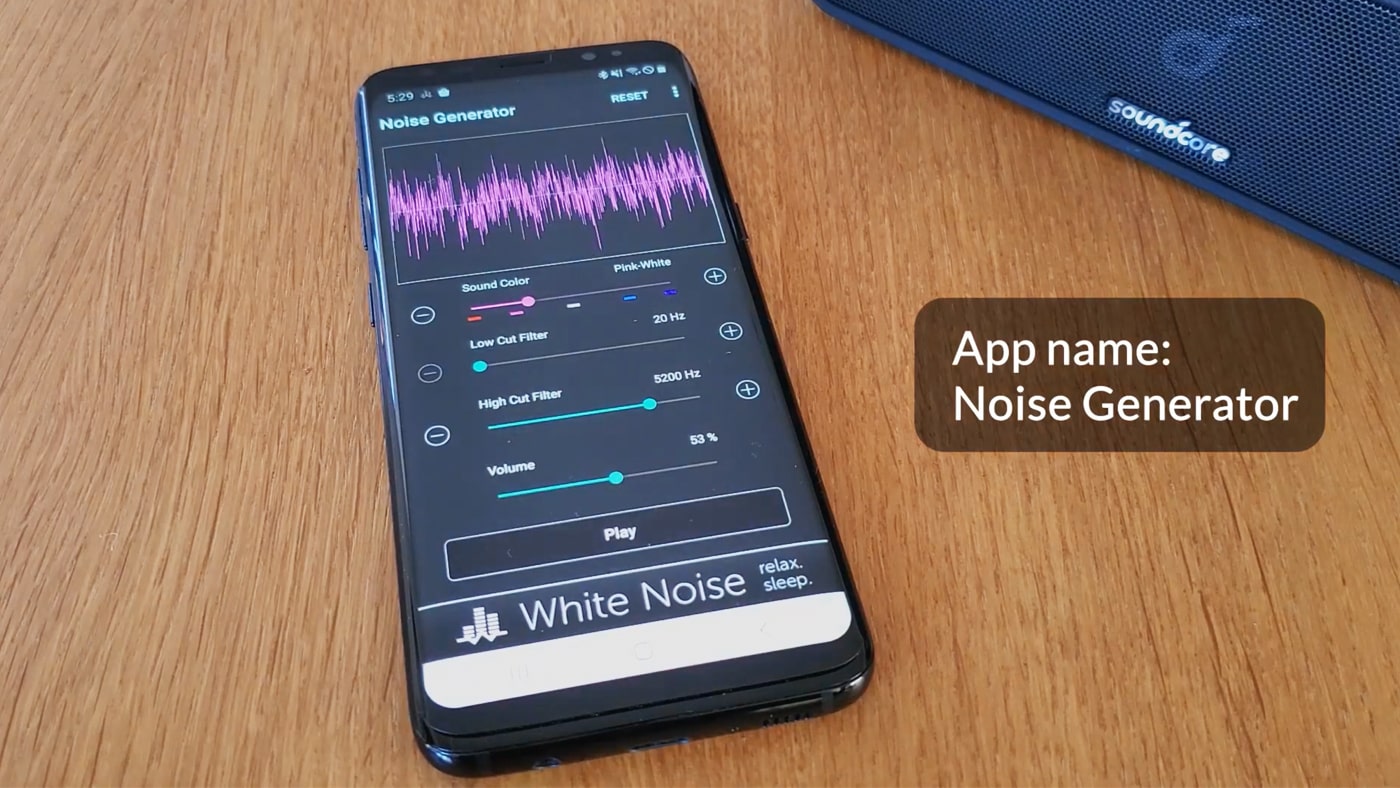
You can see that I was playing around with the filters, which means that you can adjust the sound and tailor it to however you like.
Another one that I really like, probably my favorite at the moment, is Atmosphere. And this one’s great because you can combine so many different sounds.
In this photo, you can see the Atmosphere app:
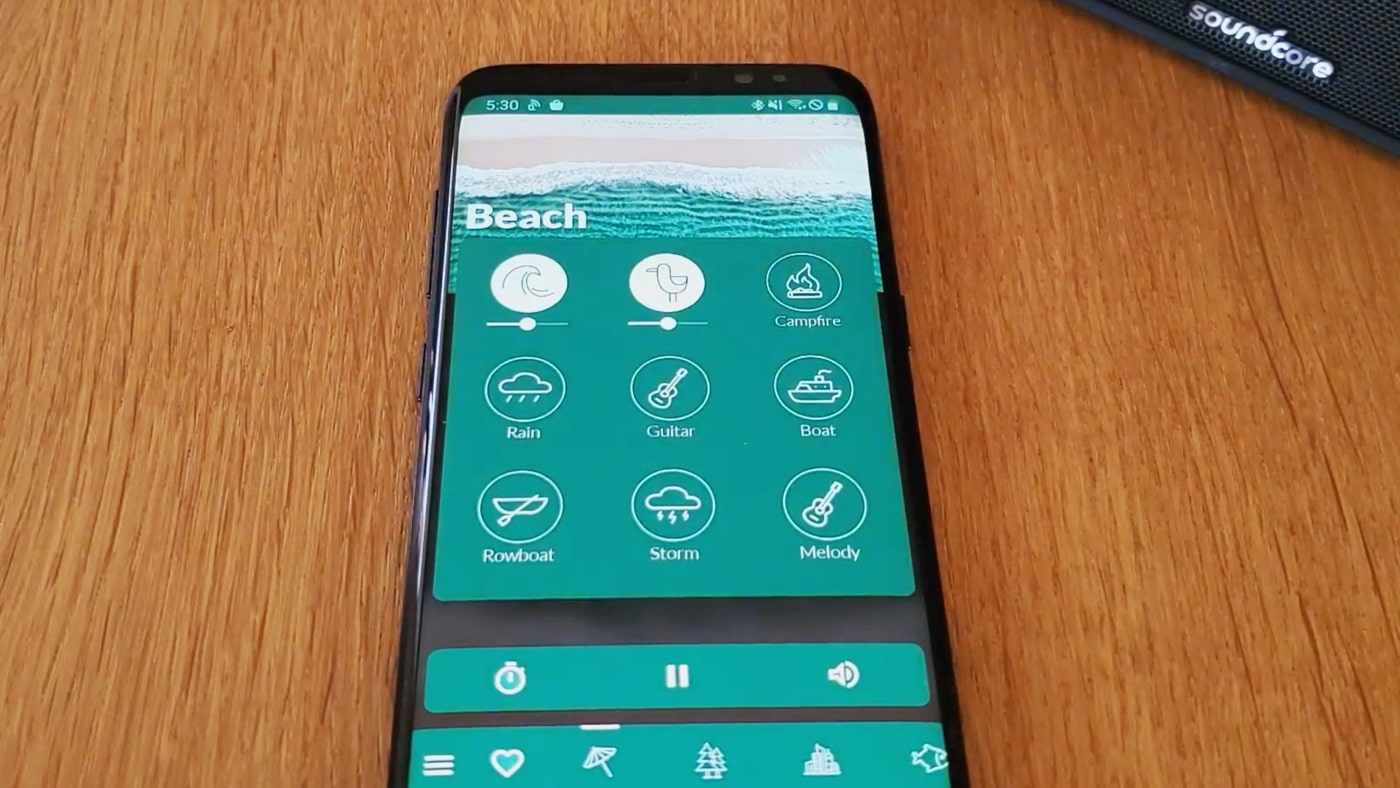
So let’s have waves and seagulls, for example. I’m going to move my phone a bit off screen as I don’t like that Ad!
Maybe you don’t want those but perhaps you’d like to go underwater instead. And let’s have some whale sounds and combine it with classical music, which I always quite like.
As I said, there are so many different sounds on this one that you can go into the different categories, and choose the ones that you like. For example, one more: let’s go to the forest and have a waterfall and maybe some crickets. And if the crickets are too loud, you can turn them down a bit and turn the waterfall up.
I really like how you can change the settings and combine so many different sounds in that one, and the volume as well, which means that you can get just the right sound.
So those are three white noise apps that I like, but as I say there are many to try. I’d recommend giving a few a go until you find the one that you like most.
Combining a Bluetooth speaker and an app
This section starts at 9.24 in the video
Another nuance in choosing a white noise machine rather than a phone app is whether you’re going to listen to it with a Bluetooth speaker or just through your phone.
I’ve found in the past that even though a phone speaker can be quite loud, which may or may not be a good thing, there’s something very directional about the way the sound comes out of the phone.
And for me, it doesn’t fill the room in the same way that a good white noise machine will do. For example, the Lectrofan Evo has this upward-facing speaker, and it’s a much bigger speaker. It just has a more filling presence of the white noise in the room than listening to it on a phone.
So if you’re only going to listen to it through a phone and not with headphones then I would suggest that a white noise machine is a better way of filling the space, and having a more relaxing sound, and potentially blocking out more noise from other rooms or from through your window or upstairs neighbors as well.
However, if you’re going to hook up your phone to a Bluetooth speaker, or any speaker that you can connect to, then I would say that’s potentially going to be a better way than any of the white noise machines in terms of the quality of the sound if you get a decent speaker.
For example, in a previous video, I used the Sony SRSXB12 – it’s a bit of a mouthful that one – connected to my Samsung Galaxy S10.
In the photo, you can see a setup I really like: the White Noise Generator app and Sony SRSXB12 Bluetooth speaker. It’s a reasonably priced combo, sounds great, and is very easy to use.
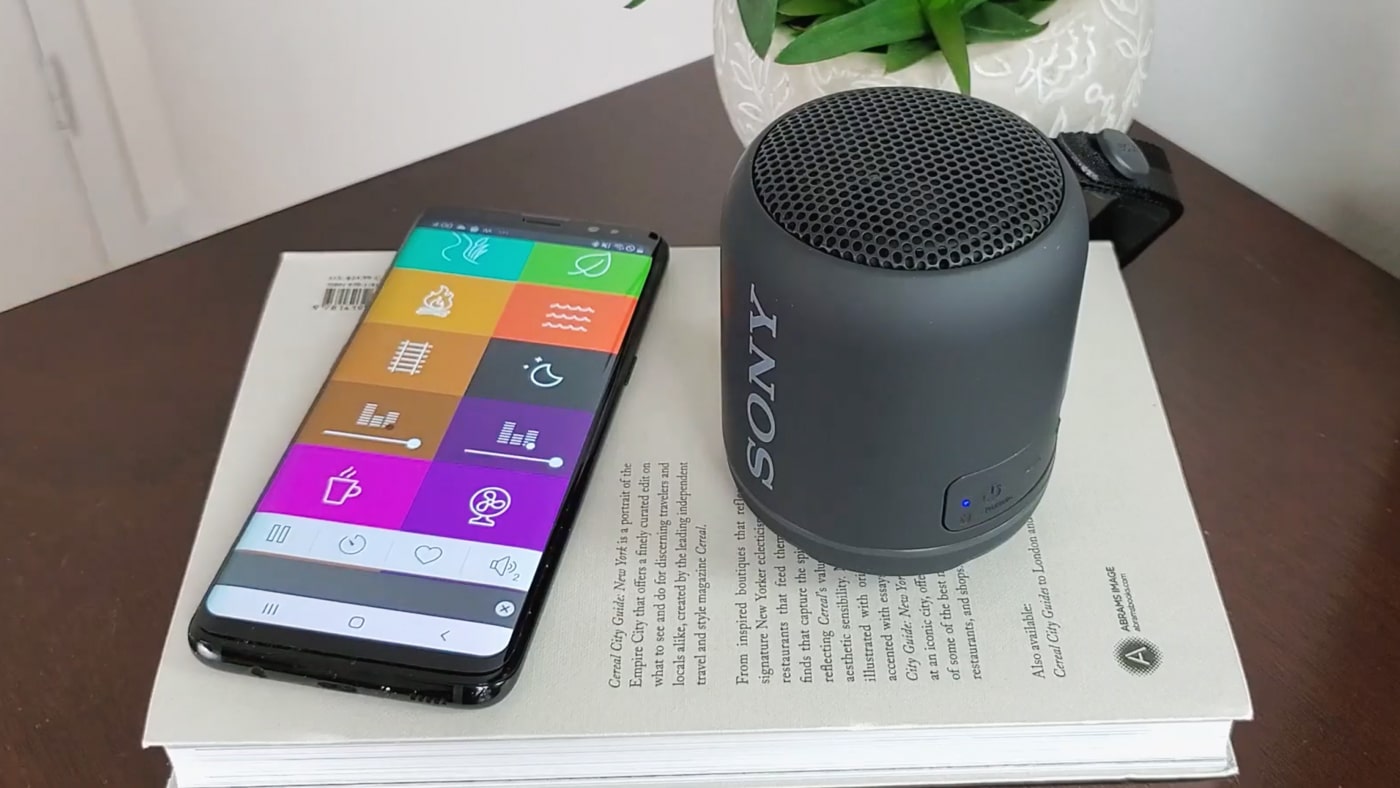
That combination of devices worked really well, with good sound quality that filled the room, especially with the bass of the pink and the brown noise. I really enjoyed listening to it through that.
And for example, the Anker Soundcore 3 is another Bluetooth speaker that I’ve been listening to recently that again was reasonably priced. I bought it for under $50, and you can easily hook it up to your phone and then you have a more filling sound that’s more capable of blocking out external noise.
Smart speakers
This section starts at 11.17 in the video
So now we’ve looked at phone apps for playing white noise, there’s another device that you might already have, or might be thinking about buying, that can play white noise very capably as well, and that’s a smart speaker.
For example, hey Google! Play white noise for one hour. Hey Google! Play rain sounds.
It’s very easy to use and very reliable, and sounds really good through that speaker as well. Hey Google! Turn off.
And here’s another example – hey Alexa! Play pink noise.
Photo below: Alexa on the Echo Dot 3rd Generation
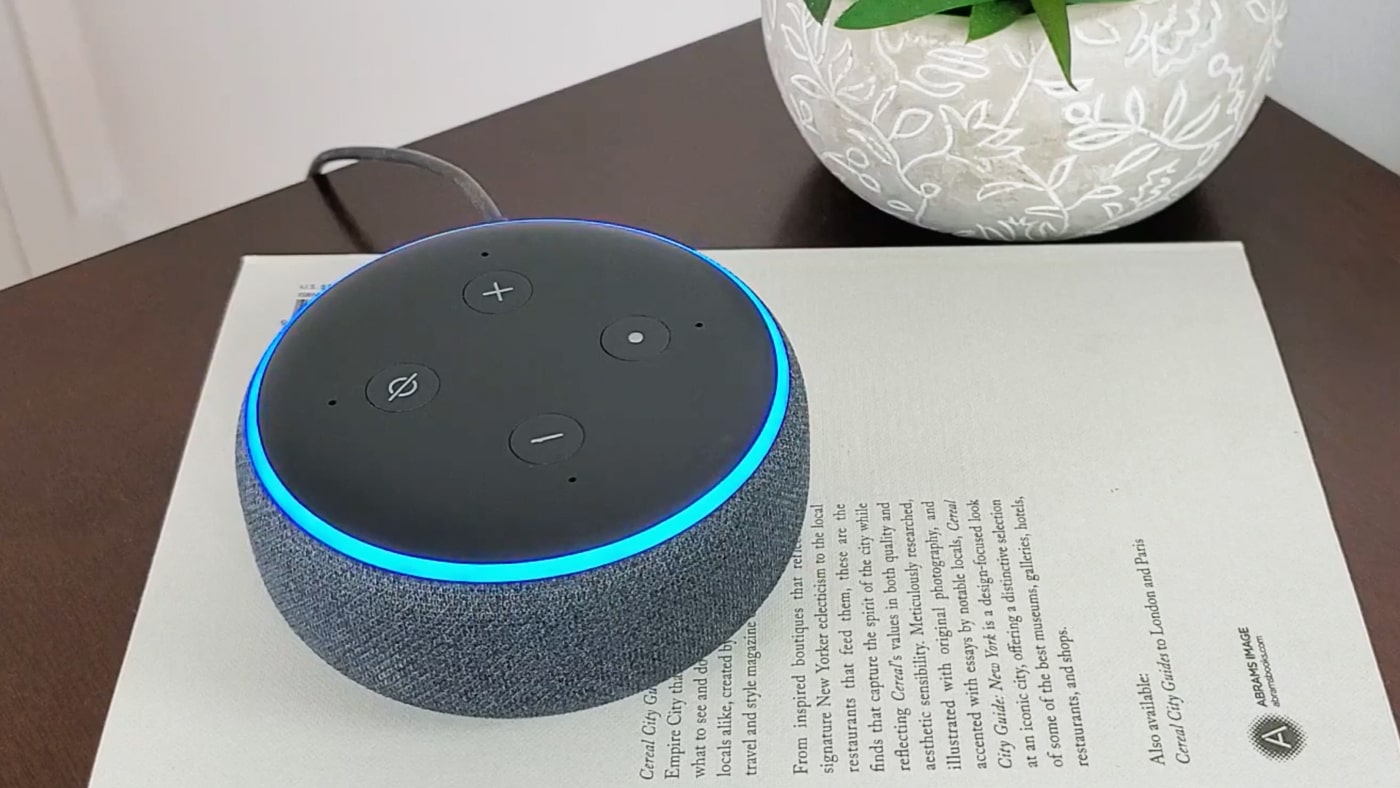
One small problem with smart speakers might be again the placement. If you’ve got it set up on a particular shelf in the living room then maybe you don’t want to be moving it around the house to your bedroom.
If you’ve got more than one, and you’ve got one in the bedroom and one in the living room or your study, then again I would say stick with that. There’s no real need to buy a white noise machine if you can play white noise on it.
And actually, I think quite a lot of people don’t really realize that you can get white noise or nature sounds on their smart speaker. I know in comments and emails that people have asked me, some people have been quite surprised and relieved to find out that they don’t need to buy a white noise machine because they’ve already got it in the house – they just didn’t realize.
So again, I think it’s another of those cases where if you’ve got it, and it works for you, and you don’t mind having a smart speaker operating in the bedroom while you’re sleeping, then that’s a good option.
Hey Google! Play brown noise.
So those are all my main thoughts about choosing a white noise machine over an existing device or downloading an app instead.
Part 2: key points to consider when choosing a white noise machine
The style of white noise machine
This section starts at 13:00 in the video
If you do decide that you want a white noise machine, how do you go about choosing the right one?
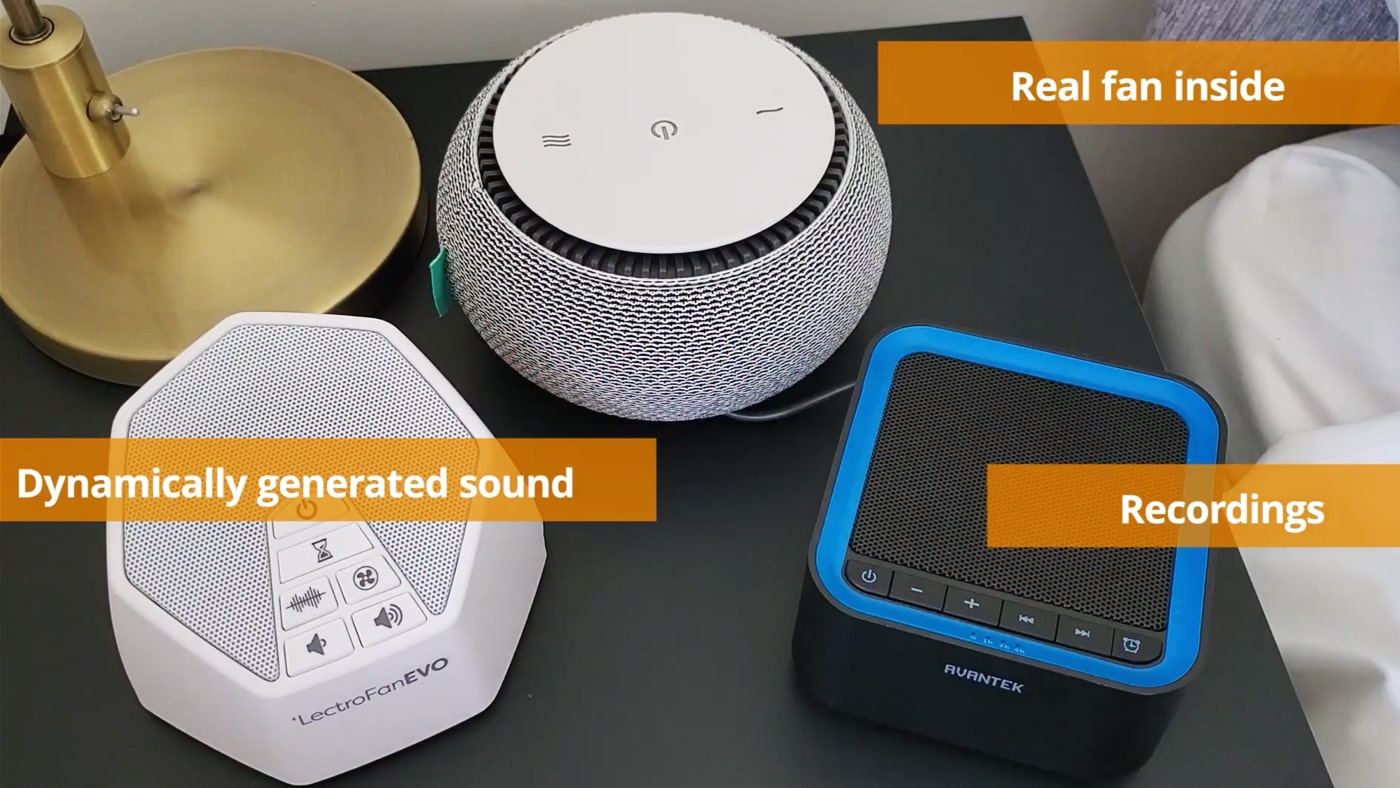
The first thing then is whether it’s one that has a real fan, recordings, or digitally generates the sounds as one or two of them say they do.
I think, if you like the idea of a fan sound and the authentic sound of air, but you don’t really want a fan blowing air around your room then get one of the ones that have a fan inside, such as the Snooz or the Dohm Uno. Those are good ones to listen to. However, do bear in mind they don’t have white noise and they don’t have nature recordings.
In this photo, you can see two white noise machines that have a real fan inside – the Dohm Uno and the Snooz:
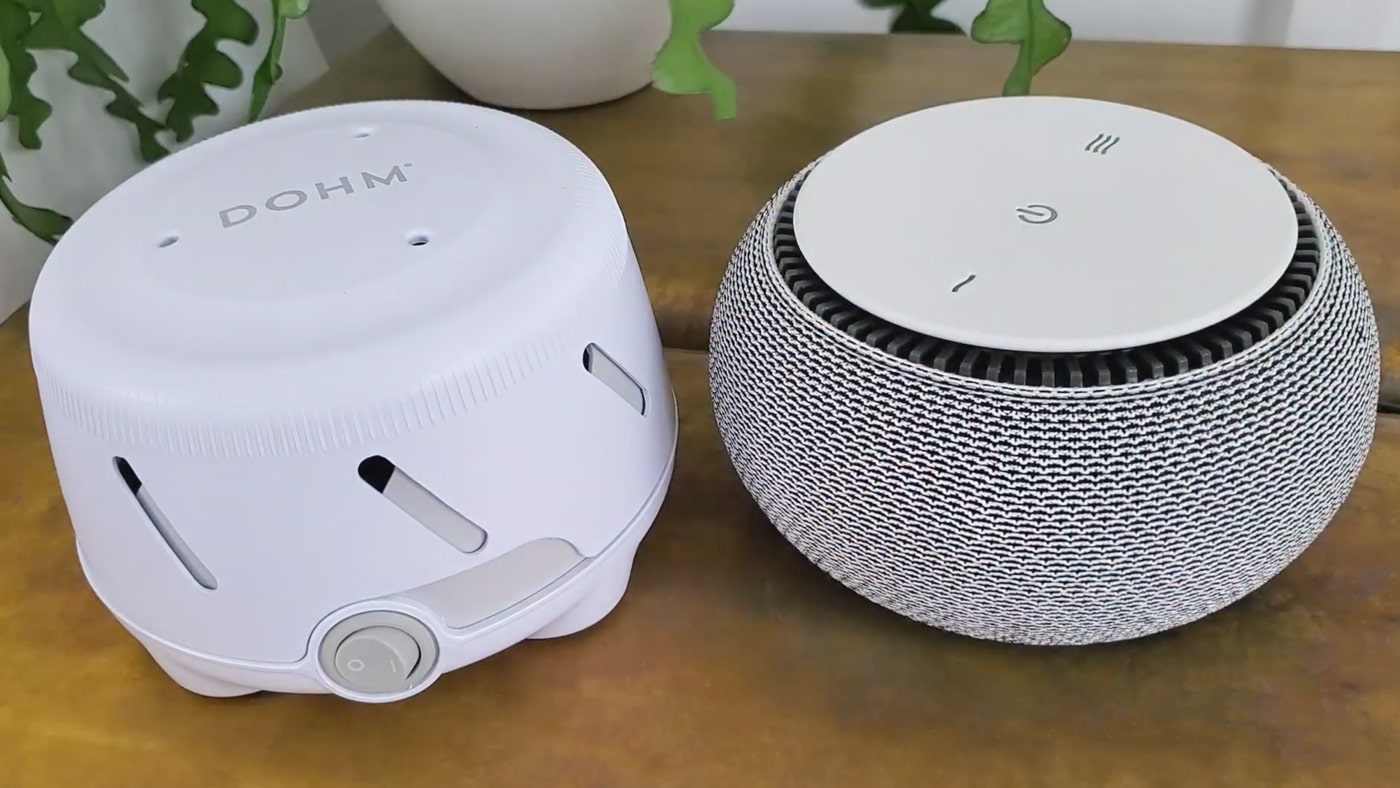
If you decide to get a white noise machine that has recordings and digitally generated sounds rather than a real mechanical fan, then it’s also worth bearing in mind that they have different quantities of nature sounds and white noise and fan sounds.
For example, the Lectrofan, which has long been one of my favorites has 10 white noise, 10 fan options, and just two ocean surf. So it’s not really rich in nature sounds, but it does have a really good variety of white noise and fan sounds.
And that’s useful because not everybody is going to like the same frequency of white noise. Some people prefer deeper pink noise and brown noise, which they find more relaxing.
And actually, there are a couple of the cheaper budget white noise machines, some of the older ones that don’t even have pink or brown noise. They just have a bright white noise that can be quite intense.
If you want nature sounds, do you want rain? Do you want thunder? Do you want ocean sounds, or rivers, or brook? Those are some of the most common ones. And if it’s got rain, does it have thunder as well or just rain?
Those are some questions to ask because sometimes I know people are disappointed when they get a white noise machine that’s got rain and then it’s got thunder, but they didn’t want thunder. Or maybe it’s got an ocean, but it’s also got some seagulls and you just don’t like seagulls.
If you’re more interested in nature sounds then ones that I would recommend looking at, especially if you like lots of variety, are the Avantek and any of the Sound+Sleep range; they tend to have a lot of different variety.
The Sound+Sleep Special Edition, for example, has 64 different sounds. That’s 16 main categories and then four variations within each of those categories. So some white noise machines that have a lot of different sounds will offer some extra sounds that some of the ones that have the basics won’t.
Volume
Another useful question to keep in mind is about the volume. A lot of these white noise machines can be really loud at the maximum volume. The Lectrofan Evo, for example, when you’ve got it blasting from a couple of meters away can be over 70 decibels, which as far as I understand it is way louder than you would ever need to play to a child or would be safe to play to a child.
The speaker quality and the way that they sound especially with nature sounds can really vary with white noise machines. If you’ve got a cheap one for $20 then you’re not really going to be able to have high expectations of the greatest sound quality coming out of that little speaker.
So it’s another good reason to get a decent white noise machine, perhaps not one of the budget options. They can be particularly lacking in bass I find.
Auto-off timers
This section starts at 16:36 in the video
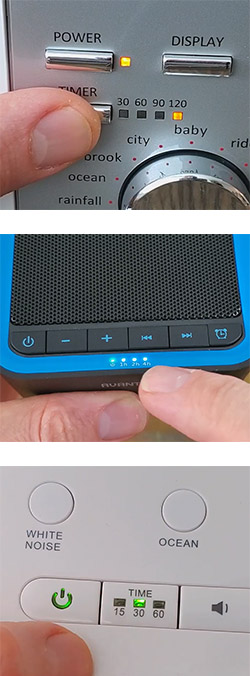
In the photos, you can see the small LEDS used by three white noise machines to indicate the auto-off timer selected.
The top photo is the Sound+Sleep, with timers from 30 to 120 minutes. The middle photo is the Avantek, with timers from 1 – 7 hours. And the bottom one is the Big Red Rooster, with timers from 15 to 60 minutes.
All of them can be played continuously if you don’t select a timer.
Another useful thing to bear in mind is the auto-off timers. For example, the Lectrofan Micro 1 and 2, the Dohm Uno, and the Dohm DS don’t have timers. But most of them do have timers.
One exception I find a bit strange is the Snooz, which is a feature-rich white noise machine. I really like it, but it only has timers accessible via a smartphone app. You can’t actually set the timers manually, and that’s a bit of a strange criticism of the Snooz. I don’t know why they didn’t put just one button on the top to set a timer.
All the others that I’ve looked at do have timers, but they don’t all have the same length of timer though, so that’s something to keep in mind. Quite often you find that they have 15, 30, 60, minute timers, maybe 90 minutes, maybe up to 120 minutes, but only a couple of them have hours and hours to choose from.
For example, the Avantek has one, two, four hours, and then you can also combine those settings to get up to a maximum of seven hours. One thing I like about this one as well is that it has teeny little lights, so you know exactly what the timer setting is.
With a lot of white noise machines, you don’t really get a light or a sliding button to tell you which timer it’s on. You just press the same button over and over again until you either hear a beep at the end to tell you that you’ve reached the end of the possible choices, which means that you then need to know exactly what those choices are.
So you need to have paid attention when you read the manual or have the manual in the first place, otherwise you kind of get a bit lost. So it’s useful to understand what timers it has, and what system it has of telling you which timer is currently selected.
Headphone jack
This section starts at 18:05 in the video
The next question is about whether you’d like one with a headphone jack or not. This is an increasingly common feature with some white noise machines. They don’t all have it, but more and more of them do and I think it’s really useful. It tends to be a 3.5 millimeter headphone jack – a standard pin for headphones.
What I like about that is that it gives you options for listening to white noise in bed. For example, if you’ve got someone sleeping next to you and they don’t like white noise then you can have it on the bedside table on your side, pop your headphones in, and then they don’t have to listen to it.
Below, you can see the Sound+sleep has a useful headphone jack so you can listen in private.
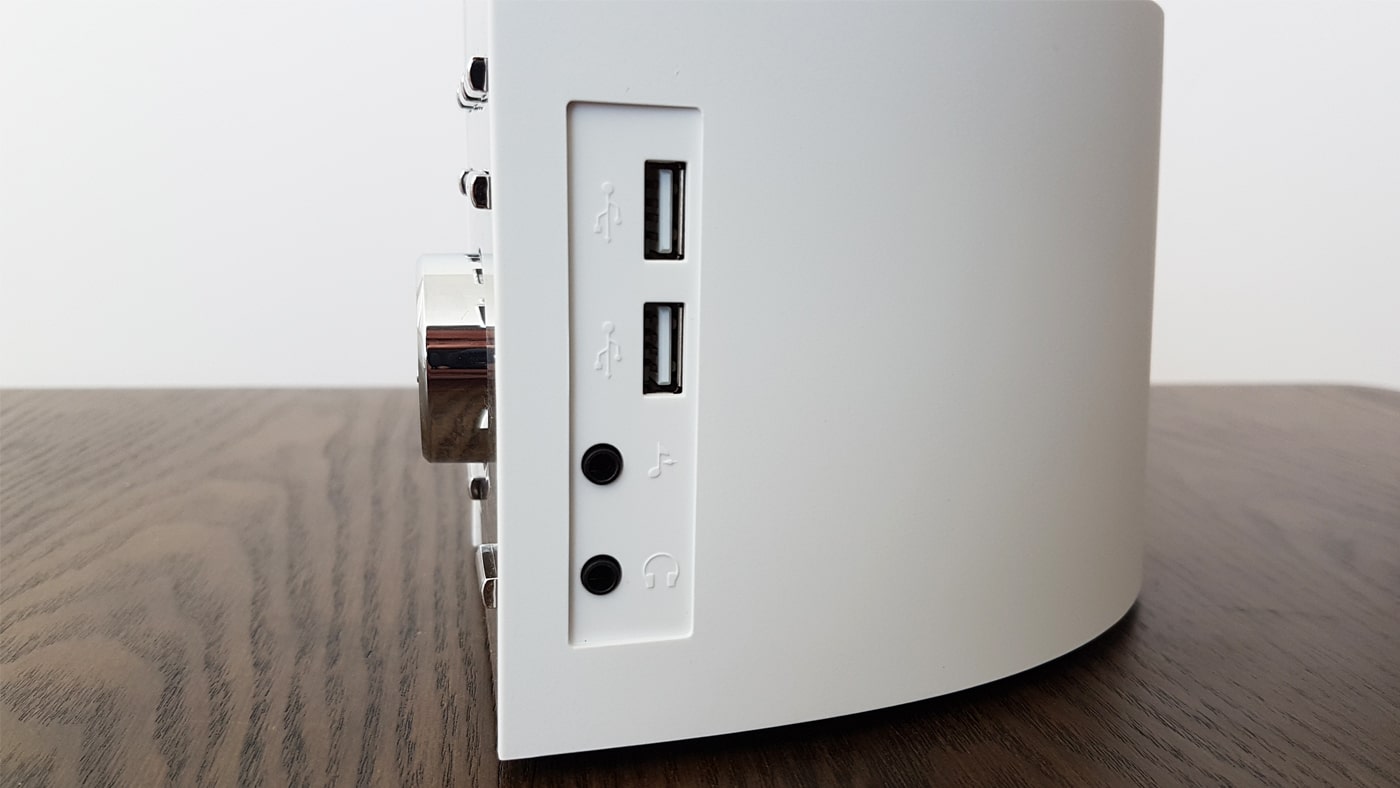
It also means that you’ve got another option for blocking out more noise from another room or from outside. Sometimes you can have the white noise playing on the bedside table, a shelf or windowsill, wherever it might be – close to the source of the noise tends to work better – but it sometimes just doesn’t block out enough.
However, if you have it closer with headphones in, it just gives you another possibility to block out more noise. And if you’ve got good headphones and you’re listening to white noise, I find it can be a little bit more successful. A couple of examples of good white noise machines that have the headphone jack are the Lectrofan Evo and the Sound+Sleep range.
Buttons and ease of use
This section starts at 19:06 in the video
Another useful question to consider when you’re buying a white noise machine is about the buttons. It’s a detail that isn’t always done well on these white noise machines I find.
For example, the Lectrofan Micro 2, which I really like because it has that internal rechargeable battery, it’s very portable and it can be used as a Bluetooth speaker – all those great things. But then I find it falls down with the buttons because they are tiny.
So if you’ve got big fingers like me or you’re trying to adjust it in the nighttime, it can be a little bit awkward because they’re really, really small. However, most white noise machines do have good buttons.
There’s one more bugbear of mine with some white noise machines: I really don’t like it when they have the same two buttons for volume up and down but also for track left and right.
I think that if you have to click a button or long hold the button to change settings, different settings, it’s a bit of an issue. I think if you’ve got a device that’s this size (the Avantek) there’s no real excuse not to have separate buttons for volume and for track change, which this one does. But they don’t all, and that’s something that bothers me.
Here you can see the Lectrofan Evo’s good button interface. There are separate buttons for the volume and sound choice:
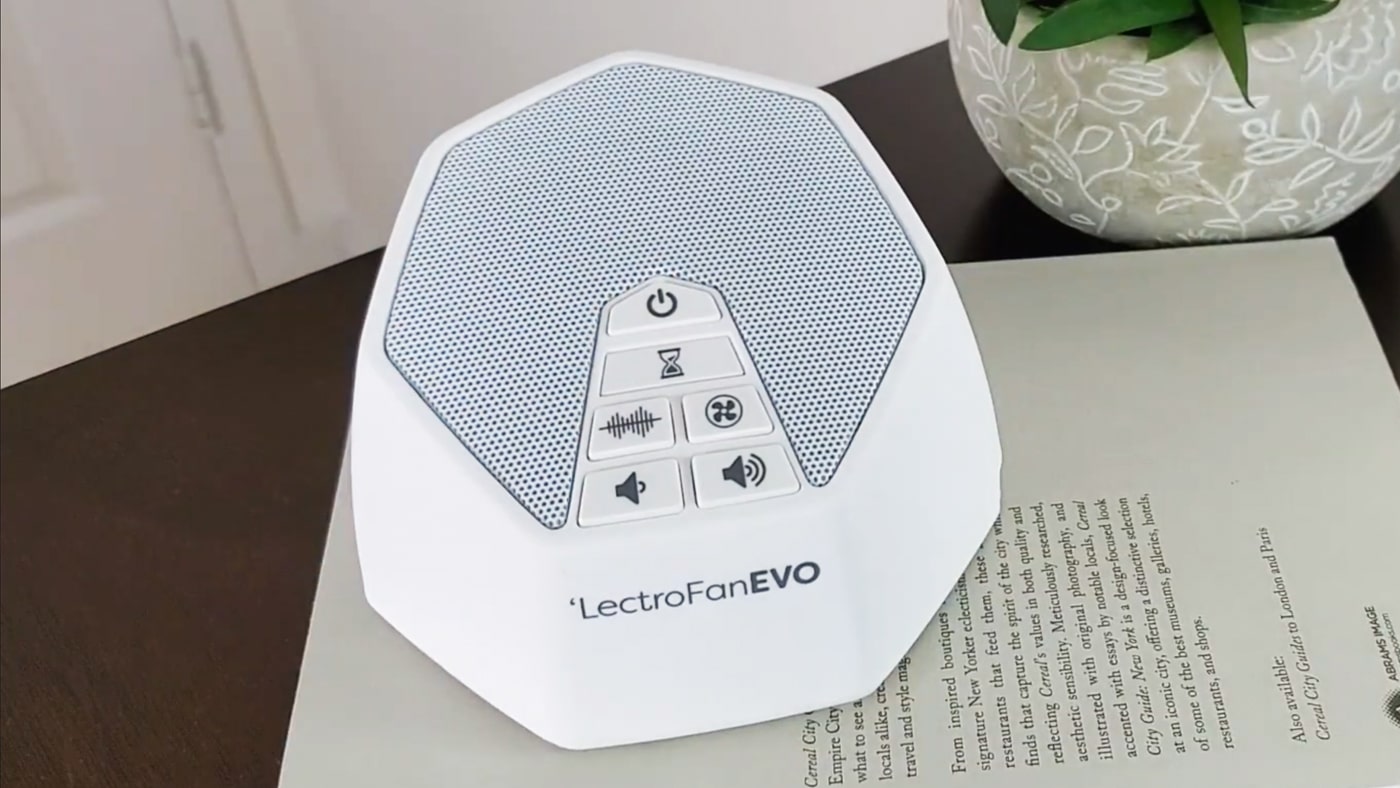
So, I think it’s just worth having a glance at the photos or in the videos, and if you listen to my reviews I always talk about that because it’s an issue that I’ve found with them, and I think is useful to consider.
Other than that, in terms of the buttons, another thing to bear in mind is that some of them that don’t have many tracks to choose from have individually labeled buttons, which is one of the good things about the Big Red Rooster. Even though I think having just six sounds isn’t very good, at least they’re individually labeled so you can just click it straight away.
With some machines, if they have lots of different sounds and just one or two buttons to choose between them, you can end up pressing that button repeatedly to go through and trying to find the sound.
And sometimes you miss things: “was that the calming fan that I liked? Oh no, it was this one. Or was it that one?” And it’s just a bit of a waste of time and kind of annoying.
A design point I like about some of them, the Lectrofan Evo for example, is when sound categories are split into different buttons. So you’ve got white noise sounds on one button and fan sounds on the other. I like the fact that it narrows your choice down right from the outset.
The Dreamegg has that as well, which is another feature that I like about that one. I just find it a little bit more user-friendly than having just one or two buttons to go through all of them backward and forwards.
In the photo below, you can see the Dreamegg D11 has large and clear buttons that split the sounds into white noise, fans, and nature sounds. That makes it easier to find the sound you want:
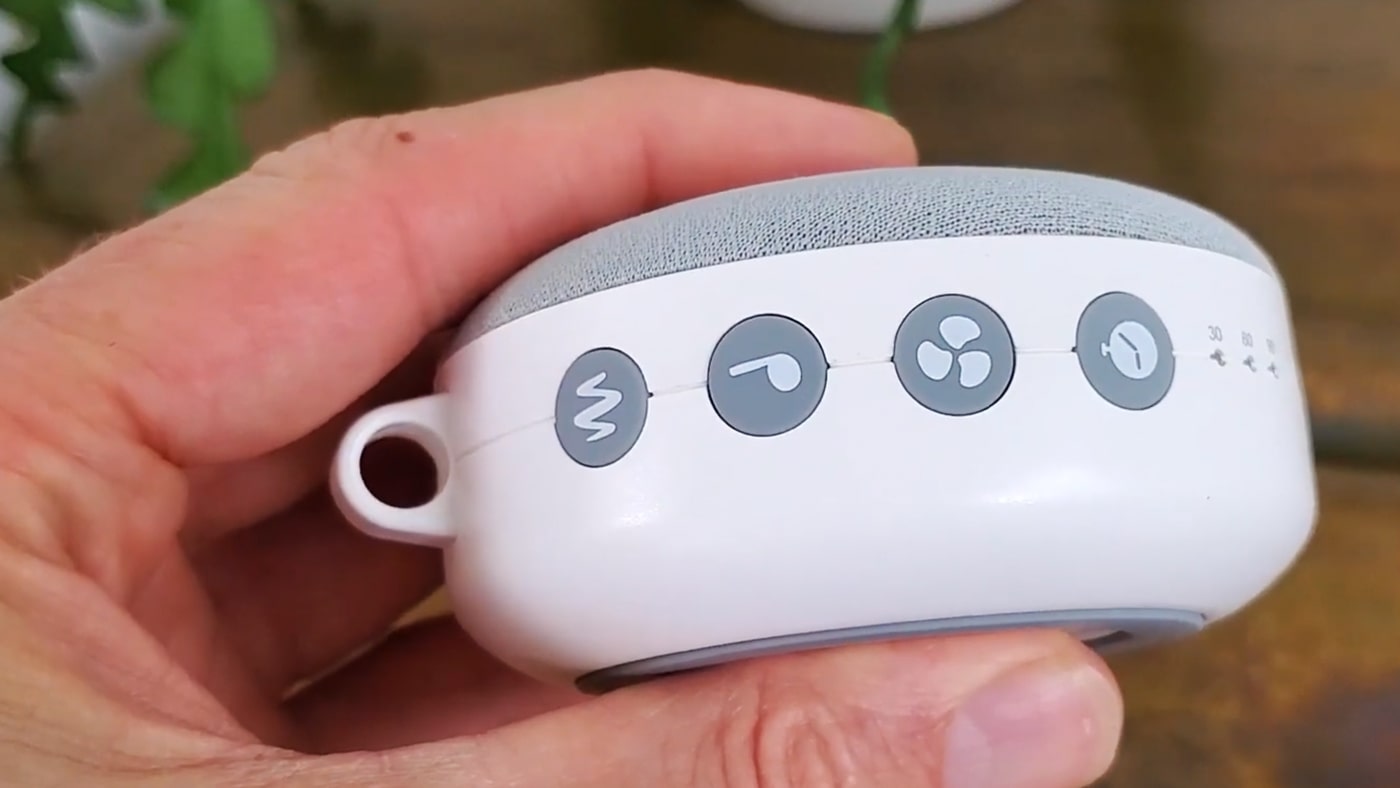
Power: adaptors, USB, internal & standard batteries
This section starts at 21:19 in the video
Another key question to consider is how are they actually powered? Most of them tend to come with a standard power adapter and/or a USB cable, so you can plug it into any USB outlet. Or you can just plug it into the wall near your bed, near your table, wherever it might be, or even sometimes plug them into a laptop or a computer if you need to.
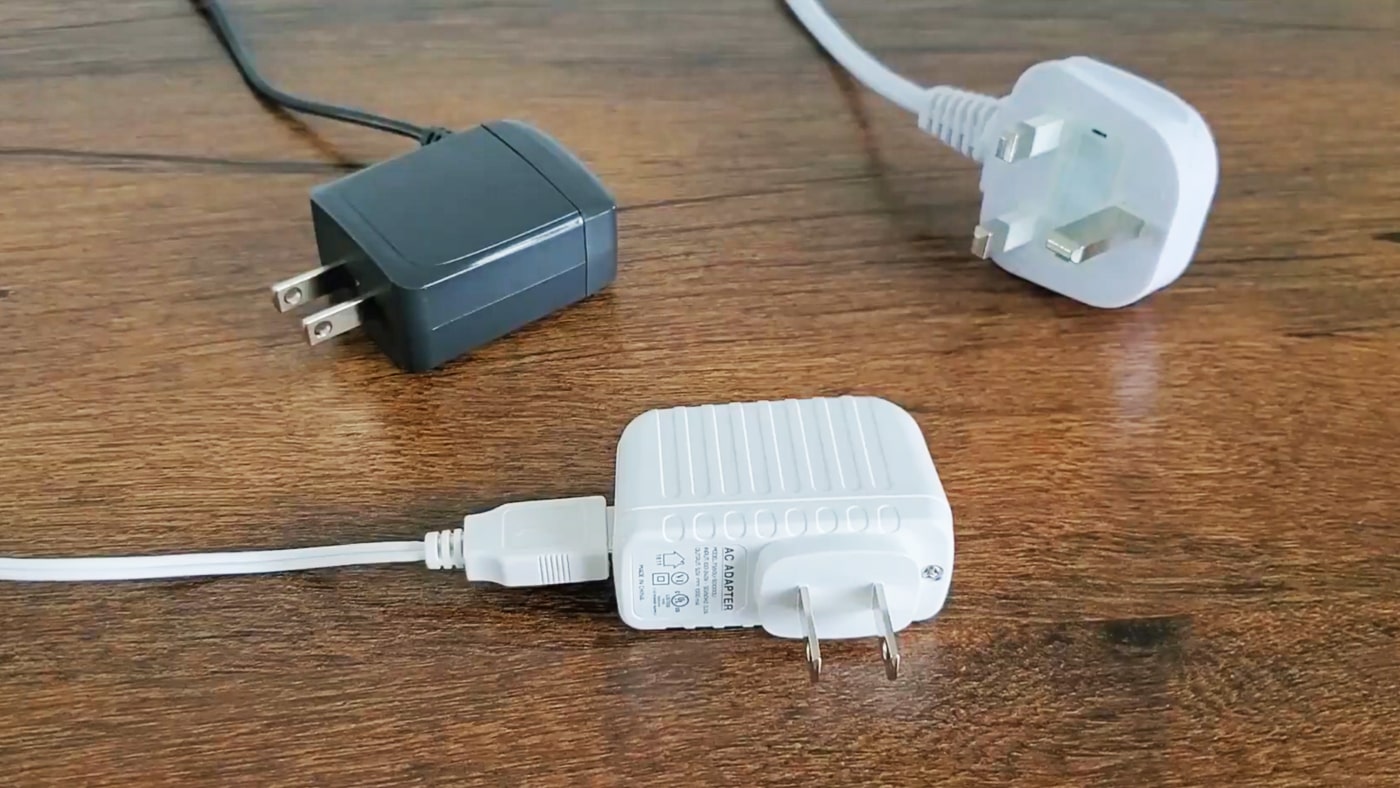
There are a few which have an internal rechargeable battery, for example the Lectrofan Micro One and Two, and the Dreamegg D3 and D11.
That’s a good option for people who want to be able to place it wherever they like in a room, and not be restricted by the proximity to the power outlet. If you’re playing it in a child’s room, it gives you more options to place it where you think is going to be safe, which is generally further away from their ears. So it’s a good little feature that some white noise machines have.
I don’t think it’s a feature I would be too worried about if I was going to be using the device in the home myself for a long period of time, because at the end of the day I’ve always got enough outlets that I can plug these machines in if I need to. But I know that some people do like to have that portability factor.
The only one that I’ve personally reviewed, and I don’t think is very common, that can be used with normal batteries is the Big Red Rooster, which takes AA batteries. So that’s an option for people who might like to power their devices with standard batteries.
Other features
This section starts at 22:32 in the video
What about other features? I think that generally, white noise machines tend to follow quite a cookie-cutter design when it comes to the features that they have. They don’t tend to have a massive range, and it tends to be the ones that are more expensive that do have some extra little features here and there. And even then, personally, I don’t really use them a lot.
For example, sometimes you can get a white noise machine that has one or two USB outlets, which might be useful but I can’t say that I’ve ever needed to use them myself because I’ve always got extra USB outlets.
One or two have some interesting features like the Sound+Sleep responsive volume control. This means that with the inbuilt microphone it’s supposed to listen out for changes in the environmental noise and then change the volume accordingly, which is kind of fun and it does work, but it’s not instantaneous.
I certainly wouldn’t really recommend paying extra for the premium just for that feature though. I would pay extra for all the extra sounds that it has, but not for that one feature.
A couple of other features that some of them have might be the night light, for example, which again isn’t particularly common. It tends to be more common, as you would imagine, for white noise machines that have been built towards the use for children and their parents. But standard white noise machines intended for adults don’t tend to have night lights.
A couple of them can be used as a Bluetooth speaker. It’s something I think I would only use as a backup Bluetooth speaker if I didn’t have a normal one to listen to music with.
Below, you can see the tiny Lectrofan Micro 2, which has in-built white noise sounds, but can also be used as a Bluetooth speaker.
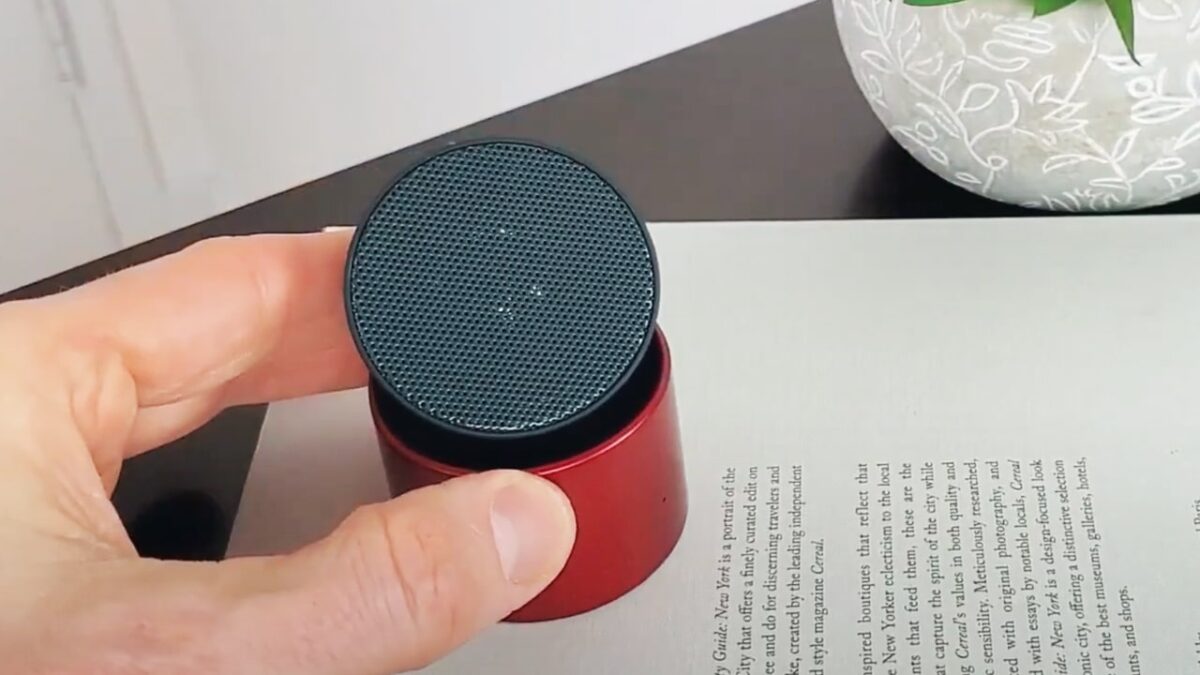
Weight, dimensions and portability
This section starts at 24:10 in the video
What about the size of the white noise machines then? This is also something that’s useful to keep in mind. Most of them tend to be relatively small – some of them are smaller than others – but none of them are absolutely enormous. None of them are as big as an old-school 1980s hi-fi, for example – imagine the white noise that would come out of that!
They tend to be pretty small though. And I think that’s because they’re designed to be used on bedside tables and the manufacturers know that people don’t want to take up a huge amount of space on a bedside table with a white noise machine.
The smallest ones that I’ve come across are the LectroFan Micros and the largest ones tend to be the Sound+Sleep range. There are also a couple of other bigger ones, like the mechanical fans such as the Snooz and the Dohm range.
All the rest of them tend to be in the middle in terms of the actual dimensions. For example, the Evo and the Avantek are a very common size for a lot of the white noise machines these days.
In terms of the weight, none of them are really heavy, but I would definitely steer away from the Sound+Sleep and the Dohms if you’re going to be taking them when you’re traveling and you’re just taking a backpack, or a suitcase, or a small hold, or whatever it might be.
I think they’re going to take up too much space and potentially weigh a bit too much as well. But any of the smaller ones are very easy to stick inside a suitcase and they’re not going to take up that much space.
In the table below you can see the weight and dimensions of different white noise machines I’ve reviewed in the past:
| Machine | Weight (Pounds) | Dimensions (Inches) |
|---|---|---|
| Sound+Sleep SE | 2.6 | 7.5 x 5.5 x 4.5 |
| Sound+Sleep | 2 | 7.5 x 5.5 x 4.5 |
| Dohm Uno | 1.6 | 6 x 6 x 4 |
| Dohm DS | 1.5 | 5.5 x 5.5 x 4 |
| Dreamegg D3 | 0.97 | 4.1 x 4.1 x 2.5 |
| Mifa | 0.83 | 6.1 x 2.6 x 5.8 |
| Lectrofan Evo | 0.8 | 4.7 x 4.7 x 3.3 |
| Avantek | 0.6 | 3.9 x 3.9 x 2.4 |
| Homedics Sound Spa | 0.5 | 6.5 x 6.5 x 2 |
| Lectrofan Micro 2 | 0.4 | 2 x 2 x 2.1 |
| Big Red Rooster | 0.37 | 4 x 4.4 x 2.6 |
| Dreamegg D11 | 0.35 | 4.6 x 4.4 x 2.3 |
| Snooz | 0.34 | 5.7 x 5.7 x 2.3 |
I think that if you are traveling, it’s definitely better to use a phone app unless you really want that white noise machine to leave in your kid’s room for example when you’re on holiday. But overall, I would say if you are thinking of traveling and portability, it’s definitely a good reason to consider using an app instead of a machine.
Price
This section starts at 25:46 in the video
The prices in the table below show the typical prices that were correct in September 2021. Note that I put the greater than (>) and less than (<) symbols because prices change on some online websites like Amazon. So my intention with the table is to show the range of prices you can expect to pay for white noise machines rather than a fixed price for each one.
| Machine | Typical price |
|---|---|
| Sound+Sleep SE | > $100 |
| Sound+Sleep | < $100 |
| Snooz | < $80 |
| Lectrofan Evo | $45 – $60 |
| Dohm DS | < $50 |
| Avantek | < $40 |
| Lectrofan Micro 2 | < $35 |
| Dreamegg D3 | < $30 |
| Dohm Uno | < $30 |
| Dreamegg D11 | < $30 |
| Mifa | < $30 |
| Big Red Rooster | < $20 |
| Homedics Sound Spa | < $20 |
The next question then is about price. With white noise machines, the first good point is that none of them are really ridiculously expensive. However, you can get a couple that are around the $100 mark, which, depending on your point of view might be ridiculously expensive!
But the good thing is that you can get some which are a lot cheaper. And actually, some of my favorite ones only cost around $40 – $50, perhaps a little bit more depending on the time of the year if they’re being sold on Amazon, which is notorious for changing prices.
The budget end of the range is around $20 – $30. And in my experience, sometimes you can get good ones for that price, but generally you really feel it in terms of the speaker quality, the overall design quality, or the looping. They tend to have much shorter loops in some of those cheaper devices, and if it’s a one minute thunder track and it’s only got three thunderclaps in that time then you’re soon going to get tired of listening to it.
So I think it’s worth thinking about,how much you want to invest in a white noise machine. Because $20 will get you one but it might not be the best one. Around $40 – $60 you can generally get a really good one, perhaps even for $30. But if you want to get the most feature-rich ones, like the Snooz and the Sound+Sleep, then you’re going to be looking at just under or just over $100.
And for some people that might seem a little bit too much for something that’s just going to play white noise that you could get for free. Which, going back to the phone app reason to have white noise on that rather than a white noise machine is the fact that it is free, apart from maybe having Ads and a paywall.
So that’s something to consider: that’s the general price range, let’s say $20 – $120 for white noise machines, but it’s the middle of that range that really hits the sweet spot for me.
Summary
And that’s about it for my video on white noise machines, and smartphone apps, and smart speakers, and household appliances. I hope you found it helpful.
If there are any questions that I haven’t answered though, please let me know in the comments. I’ll see if I can help out, and it will be good to hear from you as well. And please also subscribe to my YouTube channel to keep in touch and see future videos. Thanks again, this is Ethan from No Sleepless Nights.
Links to buy the white noise machines and speakers
White noise machines
Lectrofan evo – Amazon
Avantek – Amazon
Snooz – Getsnooz.com
Dohm Uno – Yogasleep.com
Sound+Sleep – Amazon
Big Red Rooster – Amazon
Dreamegg D3 – Amazon
Dreamegg D11 – Amazon
Homedics Sound Spa – Amazon
LectroFan Micro 2 – Amazon
Smart speakers
Echo Dot (3rd Gen) – Amazon
Google Nest Mini – Store.google.com
Bluetooth speakers
Sony SRSXB12 – Amazon
Anker Soundcore 3 – Amazon
You might also like
For more recommendations and information about individual white noise machines, you might like to read my white noise machine reviews. In that article, you can compare more specificiations of each device, and see videos in which I play through all their sounds.

